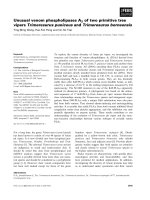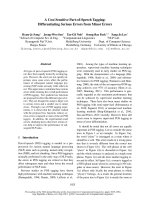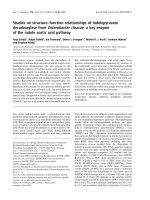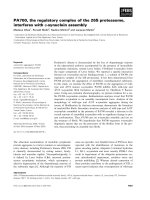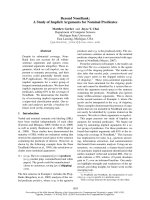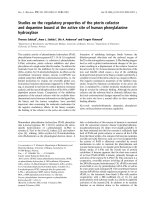báo cáo khoa học: "Studies on dairy production of milking ewes I. - Estimates of genetic parameters for total milk composition and yield " pptx
Bạn đang xem bản rút gọn của tài liệu. Xem và tải ngay bản đầy đủ của tài liệu tại đây (753.13 KB, 16 trang )
Studies
on
dairy
production
of
milking
ewes
I. -
Estimates
of
genetic
parameters
for
total
milk
composition
and
yield
F. BARILLET
D. BOICHARD
LN.R.A.,
Station
da
melioration
Génétique
des
Animaux,
Toulouse,
BP 27,
F 31326
Castanet-Tolosan
(*)
LN.R.A.,
Station
de
Genetique
quantitative
et
appliquee,
F
78350
Jouy-en-Josas
Summary
Genetic
parameters
for
dairy
traits
in
first
lactation
(milk
yield,
fat
and
protein
yields,
fat
and
protein
contents)
were
estimated
from
records of
1487
Lacaune
ewe
lambs
born
from
102
young
rams
undergoing
progeny
test
and
74
proven
rams.
Variance
and
covariance
components
were
estimated
by
H
ENDERSON
’S
methods
I
and
III.
According
to
the
analysis,
information
from
proven
rams
was
totally
or
partially
used
for
estimating
fixed
effects,
or
was
excluded.
Results
appeared
similar
to
the
average
literature
data
for
dairy
cows,
except
the
correlation
between
fat
and
protein
contents,
which
was
rather
high
(0.8).
The
genetic
standard
deviation
of
fat
was
larger
than
that
of
protein,
the
ratio
being
about
1.3
for
yields
and
1.85
for
contents.
Accordingly,
expected
genetic
change
is
likely
to
be
smaller
for
protein
matter
than
for
fat
matter.
Whereas
the
genetic
correlation
between
fat
content
and
yield
was
positive,
the
genetic
correlations
between
protein
content
and
yield,
or
between
content
of
one
component
and
yield
of
the
other,
seemed
to
be
close
to
zero
and
maybe
negative.
Accordingly,
the
selection
criterion
should
include
useful
yield
and
content,
instead
of
the
useful
yield
alone.
Useful
yield
(or
content)
was
defined
as
a
combination
of
fat
and
protein
yields
(or
contents),
with
weighting
I
and
1.85
respectively.
Key
words :
Dairy
ewes,
milk
composition,
milk
yield,
genetic
parameters,
selection
goal.
Résumé
Etudes
sur
la
production
laitière
des
brebis
traites
1. -
Paramètres
génétiques
de
la
quantité
et
composition
totale
du
lait
à
la
traite
Les
paramètres
génétiques
des caractères
laitiers
(quantité
de
lait,
de
matière
grasse
et
de
matière
protéique,
taux
butyreux
et
protéique)
sont
estimés
à
partir
d’un
fichier
de
1
487
agnelles
de
race
Lacaune
en
1’"
lactation,
issues
de
102
béliers
de
testage
et
74
mâles
de
service.
Ils
sont
estimés
par
décomposition
de
la
variance
et
de
la
covariance
entre
demi-soeurs
de
père,
en
appliquant
les
méthodes
1
ou
III
d’H
ENDERSON
,
aux
données
de
testage.
L’information
des
pères
de
service
est
utilisée
en
totalité,
partiellement,
ou
ignorée,
pour
estimer
les
effets
fixés.
Les
résultats
obtenus
selon
ces
3
analyses
sont
cohérents
entre
eux,
et
globalement
conformes
à
la
moyenne
bibliographique
connue
en
vache
laitière,
à
l’exception
de
la
corrélation
génétique
entre
les
taux
butyreux
et
protéique
qui
ici
apparaît
plus
élevée
(0,8).
La
matière
grasse
est
plus
variable
que
la
matière
protéique,
puisque
le
rapport
des
écarts-types
génétiques
est
estimé
à
1,3
pour
les
quantités
et
à
1,85
pour
les
taux.
Les
possibilités
d’évolution
génétique
de
la
matière
grasse
sont
donc
plus
importantes
que
celles
de
la
matière
protéique.
Alors
que
la
corrélation
génétique
entre
le
taux
butyreux
et
la
quantité
de
matière
grasse
est
positive,
les
corrélations
génétiques
entre
le
taux
protéique
et
sa
matière,
ou
entre
un
taux
et
la
quantité
de
l’autre
matière,
sont
proches
de
zéro,
et
peut-être
négatives.
Il
est
conseillé
en
conséquence
de
sélectionner
sur
une
combinaison
linéaire
de
la
quantité
et
du
taux
moyen
de
matière
utile,
plutôt
que
sur
la
matière
utile
seule.
Les
critères
«
quantité
ou
taux
moyen
de
matière
utile
»
sont
eux-mêmes
définis
comme
une
combinai-
son
des
quantités
(ou
taux)
de
matière
grasse
et
protéique,
avec
des
pondérations
économiques
égales
respectivement
à
1
et
1,85.
Mots
clés :
Brebis
laitières,
composition
du
lait,
quantité
de
lait,
paramètres
génétiques,
objectif
de
sélection.
I.
Introduction
Since
the
1960’s
the
main
selection
goal
for
dairy
ewes
was
limited
to
the
milk
yield.
Two
reasons
motivated
this
choice.
On
the
one
hand,
the
low
level
of
milk
production
with
a
high
concentration
necessitated
the
fast
development
of
a
selection
scheme.
On
the
other
hand,
recording
the
milk
concentration
on
the
farm
was
not
economically
feasible
within
the
usual
type
A
procedure,
i.e.
two measurements
a
day
once
a
month.
Nowadays
the
selection
scheme
applied
to
the
whole
Lacaune
population
is
producing
a
continual
improvement
in
milk
yield
(B
ARILLET
et
al.,
1986).
The
selection
program
may
now
be
reexamined
in
order
to
take
into
account
the
milk
composition,
since
sheep
milk
is
exclusively
processed
into
cheese.
That
question
involves
three
steps :
a
new
definition
of
the
main
selection
criterion,
the
design
of
a
simplified
recording
procedure
for
milk
composition,
suited
to
the
species
at
a
reasonable
cost,
and
the
integration
of
that
procedure
in
the
selection
scheme.
The
genetic
parameters
for
yields
and
milk
composition
are
to
be
estimated
first,
especially
since
the
literature
on
that
topic
is
very
scarce
for
the
dairy
ewes.
In
order
to
achieve
that
aim,
a
qualitative
dairy
recording
procedure
of
type
A
(two
milkings
a
month)
has
been
experimentally
set
up
on
6 798
ewes
of
the
Lacaune
selection
nucleus
between
1979
and
1981.
II.
Material
and
methods
A.
Definition
of
the
variables
Milk
yield
of
dairy
ewes
is
defined
in
France
by
the
production
at
the
milking
period
only,
after
one
month
of
suckling.
Accordingly,
only
the
decreasing
part
of
the
lactation
curve
is
recorded
while
the
milk
concentration
is
increasing
throughout
that
period.
The
following
variables
for
this
milking
period
were
analysed :
milk
yield
(M),
fat
and
protein
yields
(F,
P),
fat
and
protein
contents
(F
%,
P
%),
days
of
milking
(D),
daily
milk
production
(DM),
as
M
divided
by
D,
and
ratio
of
fat
to
protein
content
(F %,
P %).
Yield
traits
were
corrected
for
days
of
milking
by
the
multiplicative
factor
k of
the
French
dairy
sire
evaluation
scheme
(PouTous
et
al.,
1981),
as
follows :
Above
120
days
of
milking,
yields
do
not
depend
any
more
on
days
of
milking,
while
under
this
threshold,
correlations
between
yields
and
days
of
milking
remain
highly
positive.
Accordingly,
the
within
flock
variability
is
more
homogeneous
and
heritability
of
the
traits
is
increased
(P
OUTOUS
&
MocouoT,
1975).
Useful
yield
(U)
and
content
(U
%)
were
defined
as a
combination
of
fat
and
protein
yields
or
contents,
with
weightings
of
1
and
1.85
respectively :
U
and
U
%
were
the
main
and
secondary
selection
criteria
respectively.
B.
Material
The
Lacaune
selection
nucleus
comprises
105
000
ewes
in
320
herds,
for
which
only
milk
yield
was
recorded
up
to
1985.
However
milk
composition
was
experimentally
recorded
between
1979
and
1981
for
2
045
primiparous
ewes
distributed
in
26
year
x
flock
groups.
The
present
analysis
was
restricted
to
the
year
x
flock
groups
where
at
least
three
young
unproven
and
two
proven
rams were
used,
in
order
to
obtain
a
good
connection
between
flocks
in
that
sample
of
the
selection
nucleus.
The
data
set
included
1 487
first
lactations
distributed
in
22
year
x
flock
groups,
with
763
ewe
lambs
born
from
102
young
rams
undergoing
progeny
test,
and
724
born
from
74
proven
rams.
Table
1
summarizes
the
characteristics
of
the
data
set.
Out
of
the
proven
rams,
27
males
with
427
daughters
in
22
year
x
flock
groups
were
responsible
for
the
greatest
part
of
the
connection
between
flocks.
In
order
to
reduce
sampling
error,
only
the
young
rams
tested
with
at
least
three
daughters
were
kept
in
the
above
data
set
for
the
analysis.
This
threshold
was
rather
low
because
progeny
groups
were
incomplete
in
the
qualitative
recorded
sample :
the
sires
had
eight
daughters
on
average
in
the
data
set
while
they
were
tested
on
30-40
daughters,
for
milk
yield
only,
in
the
whole
Lacaune
selection
nucleus
(B
ARILLET
&
E
LSEN
,
1979).
C.
Methods
of
analysis
Genetic
parameters
were
estimated
by
variance
and
covariance
analysis
of
half
sisters
data.
In
order
to
avoid
bias
due
to
selection
(R
OBERTSON
,
1977),
only
the
102
young
rams
were
taken
into
account.
However,
using
the
information
of
all
proven
sires
or
of
the
most
widely
used
proven
rams
led
to
a
better
estimation
of
fixed
effects.
The
three
following
analyses
were
conducted
(table
1).
1.
Analysis
7
Henderson’s
method
1
(H
ENDERSON
,
1953)
was
applied
to
the
data
of
young
ram’s
daughters,
with
the
sire
effect
as
random.
Data
were
previously
corrected
for
fixed
effects
(age
at
lambing,
month
of
lambing,
year
x
flock)
which
were
estimated
on
the
whole
data
set
with
a
complete
model
including
young
and
proven
sires
effects
and
environmental
effects.
Owing
to
this
type
of
correction,
this
method
was
very
close
to
Henderson
method
II
but
the
reduction
in
the
number
of
degrees
of
freedom
was
not
taken
into
account.
2.
Analysis
2
Variance
and
covariance
components
were
estimated
by
Henderson’s
method
III
(H
ENDERSON
,
1953).
The
model
was
derived
from
HILL
et
al.
(1983),
M
EYER
(1984)
and
V
AN
V
LECK
(1985).
Proven
sires
were
considered
as
fixed
effects
in
order
to
improve
connection
between
year
x
flock.
The
sample
gathered
427
ewe
lambs
born
from
the
27
most
widely
used
proven
sires
and
763
daughters
of
young
unproven
rams.
The
model
was
the
following :
with
li
a
constant,
M¡
the
month
of
lambing
effect,
Aj
the
age
at
lambing
effect,
YF,
the
year
x
flock
effect,
S,
the
fixed
effect
of
the
sires
group,
T,
m
the
within
group
fixed
effect
of
the
proven
sire
or
the
random
effect
of
the
young
ram,
assumed
to
be
normally
distributed
with
zero
expectation
and
variance
(T ,
2.
E
iiklmn
the
residual
effect
assumed
to
be
normaily
distributed
with
zero
expectation
and
variance
a}.
2.
3.
Analysis
3
Variance
and
covariance
components
were
estimated
by
Henderson’s
method
III
from
the
subsample
of
the
763
daughters
of
the
102
young
rams.
The
model
included
the
effects
of
year
x
flock,
month
and
age
at
lambing
as
fixed,
and
of
young
ram
as
random.
In
the
three
analyses
approximative
sampling
errors
were
determined
as
described
by
GROSSMAN
&
NORTON
(1974).
D.
Predicted
changes
according
to
the
selection
criterion
Predicted
changes
were
estimated
as
described
by
R
ENDEL
&
R
OBERTSON
(1950).
Demographic
and
genetic
hypotheses
were
derived
from
the
actual
Lacaune
selection
scheme
(B
ARILLET
&
E
LSEN
,
1979) :
selection
pressures
on
the
four
gene
transmission
pathways,
sire-son,
sire-daughter,
dam-son
and
dam-daughter,
were
15,
33,
10
and
70
p.
100.
Generation
intervals
were
equal
to
5.5, 4.9,
4.5
and
3.5
years,
respectively.
Males
were
progeny
tested
on
40
daughters,
and
45
p.
100
of
adult
ewes
were
mated
with
unproven
rams.
Table
8
shows
the
prediction
of
asymptotic
annual
genetic
changes
under
these
hypotheses
according
to
the
selection
criterion.
III.
Results
The
estimates
of
heritability
coefficients,
genetic
and
phenotypic
standard
devia-
tions
and
genetic
correlations
are
shown
in
tables
2, 4,
5
and
7
respectively.
A.
Comparison
of
the
3
analyses
Results
obtained
from
the
three
different
analyses
were
very
consistent.
Thus,
the
structure
of
the
data
from
the
unproven
sires
could
be
considered
as
satisfactory.
Indeed,
the
demographic
constitution
of
the
Lacaune
breed
was
very
favourable
as
compared
to
the
dairy
cattle
(M
EYER
,
1985 ;
V
AN
V
LECK
,
1985 ;
B
OICHARD
&
B
ONA
i
TI
,
1987).
On
average
each
year
x
flock
group
included
34
ewe
lambs
born
from
6
young
rams,
with
a
range
of
3
to
12
sires.
The
same
pattern
was
observed
for
proven
rams
with
33
daughters
from
8
sires
on
average,
while
20
of
them
were
born
from
some
of
the
27
best-represented
rams
in
the
data
set.
More
generally
speaking,
the
large
number
of
ewe
lambs
and
of
young
rams
in
each
year
x
flock
group
may
compensate
for
the
possible
lack
of
connection
between
sires
and
year
x
flock.
B.
Heritability
coefficients
Heritability
of
the
days
of
milking
(D)
was
rather
low,
from
0.07
to
0.09
according
to
the
analysis
(table
2),
thus
justifying
the
partial
correction
of
the
yields
that
are
phenotypically
very
correlated
to
the
days
of
milking.
The
corrected
variables
(CM,
CF
and
CP)
were
more
heritable
than
the
original
variables
(M,
F
and
P)
in
agreement
with
P
OUTOUS
&
M
OCQUOT
(1975).
Heritability
of
milk
yield
(M
and
CM)
varied
from
0.27
to
0.32
according
to
the
analysis.
This
result
was
in
agreement
with
the
average
literature
data
for
milking
ewes :
!.29
(D
ASSAT
&
MASON,
1954 ;
F
INCI
,
1957 ;
D
ASSAT
&
S
ARTORE
,
1962 ;
B
OY
-
AZOGLU
Bt
l
ll.,
1965 ;
S
OLLER
Bl
al.,
1966 ;
C
ALCED
O
O
RD
ONE
Z,
1968 ;
H
INKOVSKI
,
1968 ;
BoNELLI,
1969 ;
H
ORAK
,
1969 ;
T
ECZA
,
1969 ;
M
INEV
et
al.,
1971 ;
RoMER et
al.,
1971 ;
Y
ARKIN
&
T
UNCEL
,
1972 ;
O
JEDA
S
AHAGUN
,
1974 ;
C
ASU
et
C
ll.,
1975 ;
F
LAMANT
&
C
ASU
,
1977 ;
C
ARRIEDO
&
S
AN
P
RIMITIVO
,
1982 ;
M
AVROGENIS
,
1982 ;
B
OICHARD
et
C
ll.,
1984).
The
heritabilities
for
fat
yield
(0.23
to
0.29)
and
protein
yield
(0.22
to
0.27)
were
similar
and
slightly
smaller
than
that
for
milk
yield.
Estimated
heritabilities
for
contents
were
much
higher
and
similar,
between
0.49
and
0.62
for
fat
content,
and
between
0.47
and
0.53
for
protein
content.
These
results
were
consistent
with
the
average
literature
data
for
dairy
cows,
reviewed
in
1974
by
M
AOALA
&
H
ANNA
(table
3)
and
reported
by
others
since
that
time
(DEB
et
al.,
1974 ;
ToNG et
al.,
1976 ;
H
ARDIE
et
al.,
1978 ;
H
ARGROVE
et
al.,
1981 ;
D
ANELL
,
1982 ;
K
ARRAS
&
S
CHLOTE
,
1982 ;
P
APE
et
al.,
1983
a ;
ALPS
et
al.,
1984 ;
M
EYER
,
1984 ;
S
CHNEEBERGER
&
H
AGGER
,
1984 ;
M
EYER
,
1985 ;
B
OICHARD
&
B
ONA
Y
TI
,
1987).
However,
only
two
studies
of
genetic
parameters
for
milk
composition
in
dairy
ewes
are
known
to
us.
These
estimates
were
obtained
from
two
experimental
flocks
in
the
Sarde
breed.
The
first
one,
for
fat
content
only
(BorrELtt,
1969)
was
similar
to
ours.
The
second
study,
involving
both
protein
and
fat
(C
ASU
et
al.,
1975 ;
F
LAMANT
&
C
ASU
,
1977),
reported
estimates
very
different
from
ours,
in
particular
for
protein
content.
C.
Genetic
standard
deviation
estimates
(table
4)
Fat
yield
and
content
were
more
variable
than
protein.
According
to
the
analyses,
genetic
standard
deviations
ranged
respectively
from
1.24
to
1.30
kg
for
CF,
0.94
to
0.95
kg
for
CP,
4.3
to
4.9
g/l
for
F
%
and
2.4
to
2.5
g/1
for
P
%.
The
ratio
of
fat
to
protein
standard
deviations
reached
about
1.30
for
yields
and
1.85
for
contents.
Similarity
of
the
results
between
species
has
to
be
pointed
out.
Indeed
the estimates
of
the
ratio
reported
by
HILL
et
al.
(1983)
and
B
OICHARD
&
B
ONA
I
TI
(1987)
are
very
close
to
ours.
Therefore
fat
traits
seem
more
likely
to
vary
than
protein
ones.
D.
Estimates
of
genetic
correlations
Milk
yield
was
more
strongly
correlated
with
protein
yield
(0.92
to
0.94)
than
with
fat
yield,
0.82
to
0.86
(table
5).
Correlation
between
fat
and
protein
yields
took
an
intermediate
position
between
the
two
previous
ones
(0.90
to
0.93).
The
average
literature
data
for
dairy
cow
show
a
very
similar
trend
(table
6),
the
correlation
between
milk
and
protein
yields
being
the
highest
(M
AUALA
&
H
ANNA
,
1974 ;
TONG
et
al.,
1976 ;
H
ARGROVE
et
al.,
1981 ;
P
APE et
al.,
1983
b ;
ALPS
et
al.,
1984 ;
M
EYER
,
1985 ;
B
OICHARD
&
BoNAm,
1987).
The
estimated
genetic
correlation
between
fat
and
protein
contents
fell
within
a
range
of
0.75
to
0.81
and
was
higher
than
the
usual
value
published
for
dairy
cows
(0.56).
However,
our
estimates
were
more
consistent
with
the
two
results
given
for
the
Sarde
breed
(C
ASU
et
al.,
1975 ;
F
LAMANT
&
C
ASU
,
1977).
Anyway,
in
both
species
a
preferential
evolution
of
one
of
the
contents
should
be
easier
to
obtain
than
for
one
of
the
matter
yields,
since
genetic
correlation
is
lower
between
contents
than
between
yields.
In
our
sample,
genetic
correlations
between
milk
yield
and
concentration
(—
0.34
to -
0.51)
were
clearly
negative
(table
5).
That
opposition
is
not
so
strong
in
dairy
cows
(table
6),
although
more
recent
studies
(H
ARGROVE
et
al.,
1981 ;
P
APE
et
al.,
1983
b ;
ALPS
et
al.,
1984 ;
S
CHNEEBERGER
&
H
AGGER
,
1984 ;
M
EYER
,
1985 ;
B
OICHARD
&
BoN
A
m,
1987)
reported
strong
negative
correlations.
Moreover,
the
genetic
correla-
between
milk
yield
and
protein
content
(—
0.47
to —
0.51)
was
stronger
than
between
milk
yield
and
fat
content
(-
0.34
to -
0.41).
Recent
papers
showed
a
similar
trend
in
dairy
cows.
Genetic
correlations
between
fat
yield
and
content
were
always
positive
and
ranged
from
0.10
to
0.24
(table
5).
This
observation
was
in
agreement
with
results
obtained
in
dairy
cows
(table
6) :
indeed
the
average
literature
data
is
0.30
without
one
negative
estimate.
However,
the
estimated
correlation
between
protein
yield
and
content
was
negative,
from —
0.09
to —
0.19.
Similarly,
correlations
between
fat
content
and
protein
yield
(-
0.05
to -
0.15)
or
between
protein
content
and
fat
yield
(-
0.04
to -
0.13)
were
slightly
negative.
Only
the
relationship
between
protein
yield
and
content
appeared
rather
atypical,
as
published
studies
show
an
average
of
0.15
over
14
estimates
with
only
4
negative
results
(table
6).
The
negative
cross-correlations
were
more
usual :
indeed
the
average
over
14
estimates
between
protein
yield
and
fat
content
is
equal
to —
0.08,
with
12
negative
results,
while
between
protein
content
and
fat
yield
it
reaches
0.04
over
14
estimates
with
7
negative
(table
6).
IV.
Discussion
The
present
results
generally
agree
with
already
published
data
for
dairy
cows
for
heritability
estimates,
for
difference
between
variabilities
of
fat
and
protein
matter
and
for
genetic
correlations
between
matter
yields
and
milk
yield,
between
milk
yield
and
both
contents,
between
fat
yield
and
content.
However,
the
genetic
correlation
between
both
contents
seems
to
be
higher
than
for
dairy
cows.
This
difference
could
be
due
to
the
lack
of
selection
on
milk
concentration
in
dairy
ewes,
while
a
selection
on
fat
content
has
been
applied
on
dairy
cows
for
a
long
time.
It
may
also
be
explained
by
a
difference
between
species,
or
between
traits,
which
are
not
exactly
the
same :
the
average
content
is
considered
over
the
whole
lactation
for
the
cow
but
only
after
a
month
of
suckling
for
the
ewe.
This
difference
could
also
be
due
to
the
low
accuracy
of
the
present
estimate,
obtained
from
a
rather
small
data
sample.
Indeed,
the
standard
error
of
the
estimated
genetic
correlation
between
contents
was
close
to
0.11
(table
7).
Neither
was
the
correlation
between
protein
yield
and
both
contents
accurately
estimated.
These
relationships
were
low
but
their
sign
could
not
be
clearly
established.
However,
the
same
question
remains
without
answer
for
dairy
cows.
The
number
of
estimates
has
to
be
pointed
out,
being
half
the
corresponding
number
of
estimates
for
fat
yield
(table
6),
because
of
the
lack
of
systematic
recording
of
protein
content
in
all
countries.
In
France,
the
sheep
milk
is
exclusively
processed
into
a
specific
cheese
known
for
its
high
ratio
of
fat
to
dry
content.
For
this
reason,
useful
matter
yield
(U)
and
content
(U
%),
defined
as
above,
were
chosen
as
main
and
secondary
selection
criteria
(B
ARILLET
,
1985).
Since
each
content
is
weighted
with
the
reciprocal
of
its
standard
deviation,
U
%
gives
the
same
economic
value
to
an
increase
of
one
genetic
standard
deviation
in
fat
as
well
as
in
protein
content.
So
the
genetic
correlation
of
U
%
was
the
same
with
F
%
as
with
P
%,
0.94
and
0.93
respectively
(table
7).
The
main
selection
criterion
U
can
be
considered
as
a
cheese
output,
i.e.
a
dry
matter
yield
(F
+
P),
by
ewe.
In
the
same
way,
the
secondary
criterion
represents
on
one
hand
the
cheese
yield
best
predicted
by
the
dry
matter
content
(F
%
+
P
%),
and
on
the
other
hand
the
fat
to
dry
matter
ratio
in
the
cheese,
corresponding
to
the
ratio
of
fat
to
protein
contents
in
the
milk
(table
8).
It
can
be
pointed
out
that
the
ratio
F
%/P
%
is
to
be
monitored
in
the
milking
ewe,
while
the
reciprocal
ratio
P
%/F
%
is
of
major
interest
in
dairy
cattle
(IVI
AI7ALA
&
H
ANNA
,
1974 ;
B
OICHARD
&
B
ONA
I
TI
,
1987).
The
genetic
correlation
between
U
and
U
%
was
null
(table
7).
Such
a
result
was
already
known
in
dairy
cattle :
using
different
weightings
(1
to
1.20)
of
protein
relative
to
fat,
B
ONA
I
TI
&
MOCQUOT
(1982),
ALPS
&
A
VERDUNK
(1984)
and
B
OICHARD
&
B
ONA
I
TI
(1987)
obtained
null
or
slightly
positive
estimates
of
genetic
correlation
between
useful
yield
and
content.
Although
selecting
exclusively
on
U
should
maintain
dry
matter
content
at
a
stable
genetic
level,
it
should
not
be
advised
in
dairy
ewes.
According
to
the
sign
of
the
genetic
correlation
between
protein
yield
and
both
contents,
this
selection
leads
to
a
possible
decrease
in
protein
content
and
to
an
almost
certain
increase
in
fat
content.
These
results
are
clearly
shown
by
the
expected
genetic
changes
(table
8)
based
on
the
demographic
hypotheses
of
B
ARILLET
&
E
LSEN
(1979).
Of
course,
selection
on
U
gives
the
largest
yearly
response
in
dry
matter
yield
(F
+
P),
0.391
kg,
while
maintaining
dry
matter
content.
But
fat
content
increases
by
0.05
g/i
each
year
while
protein
content
decreases
by
0.04
g/I.
A
regular
decrease
in
P
%
may
have,
in
the
long
term,
negative
technological
consequences.
Accordingly,
it
seems
preferable
to
use
as
selection
crite-
rion
a
combination
of
U
and
U
%,
or
U
and
P
%.
As
shown
in
table
8,
the
first
option,
with
weighting
1
for
U
expressed
in
kg
and
0.1
for
U %
expressed
in
g/1,
is
rather
satisfactory.
The
response
in
the
main
trait
(F
+
P)
is
almost
the
same
as
with
selection
on
U
only,
while
positive
yearly
gains
are
expected
for
secondary
traits :
+ 0.30
g/l
for
fat
content,
+ 0.10 g/I
for
protein
content,
+ 0.003
for
F %/
/
P %.
V.
Conclusion
This
study
was
the
first
on-farm
estimation
of
genetic
parameters
for
dairy
traits
(milk
yield
and
composition)
in
milking
ewes.
The
present
estimates
were
generally
consistent
with
those
obtained
in
dairy
cows
for
25
years.
Therefore
in
the
Lacaune
breed,
selection
on
milk
yield
must
be
discarded
and
replaced
by
the
selection
on
useful
yield.
Because
of
the
genetic
relationship
between
protein
content
and
protein
and
fat
yields,
the
selection
criterion
must
include
both
useful
yield
and
content
instead
of
useful
yield
alone.
Since
1985,
fat
and
protein
contents
were
recorded
with
a
simpler
procedure
in
the
Lacaune
breed
(B
ARILLET
et
al.,
1986)
and,
since
1986,
an
experimental
A
type
recording
procedure
was
set
up
in
some
flocks
of
the
selection
nucleus
in
the
Manech
and
Basco-Bearnaise
breeds.
In
few
years
we
will
be
able
to
obtain
more
accurate
estimates
of
genetic
parameters
for
the
main
French
breeds
from
larger
data
samples.
Received
November
25,
1986.
Accepted
April
1,
1987.
References
ALPS
H.,
A
VERDUNK
G.,
1984.
Genetische
Parameter
fur
die
Merkmale
der
Milchleistung
unter
besonderer
Berucksichtigung
des
Eiweisses
beim
Fleckvieh
in
Bayern.
II.
Summe
aus
Eiweiss
und
Fett.
Ziichtungskunde,
56,
99-107.
ALPS
H.,
R
EKLEWSKI
Z.,
A
VERDUNK
G.,
1984.
Genetische
Parameter
fur die
Merkmale
der
Milchleistung
unter
besonderer
Berucksichtigung
des
Eiweisses
beim
Fleckvieh
in
Bayern.
I.
Einzelmerkmale.
Ziichtungskunde,
56,
88-98.
B
ARILLET
F.,
1985.
Amelioration
g!nitique
de
la
composition
du
lait
des
brebis :
1’exemple
de
la
race
Lacaune.
These
de
Docteur
Ingenieur,
INA
Paris-Grignon.
B
ARILLET
F.,
E
LSEN
J.M.,
1979.
Optimisation
de
l’utilisation
de
l’insdmination
artificielle
dans
les
schemas
de
selection
des
ovins.
5’
Journees
de
la
Recherche
ovine
et
caprine,
Paris,
5-6
decembre
1979,
186-204,
ITOVIC-SPEOC,
Paris.
B
ARILLET
F.,
E
LSEN
J.M.,
R
OUSSELY
M.,
1986.
Optimization
of
a
selection
scheme
for
milk
composition
and
yield
in
milking
ewes :
example
of
the
Lacaune
breed.
3rd
World
Congress
on
Genetics
applied
to
Livestock
Production,
Lincoln,
July
16-22,
1986,
D
ICKERSON
G.E.,
J
OHNSON
R.K.,
(ed.),
658-664,
University
of
Nebraska,
Lincoln.
B
OICHARD
D.,
B
ARILLET
F.,
B
ODIN
L.,
1984.
Influence
des
modalites
de
reproduction
sur
la
production
laitiere
a la
traite
des
agnelles
de
race
ovine
de
Lacaune.
9&dquo;
Journées de
la
Recherche
ovine et
caprine,
Paris,
4-5
décembre
1984,
399-414,
ITOVIC-SPEOC,
Paris.
B
OICHARD
D.,
BONA!iTi
B.,
1987.
Genetic
parameters
for
first
lactation
dairy
traits
in
Friesian,
Montbéliarde
and
Normande
breeds.
Genet.
Sg
l.
Evol.,
19,
3,
337-350.
B
ONA
I
TI
B.,
M
OCQUOT
J.C.,
1982.
Etudes
sur
la
production
laitière
des
bovins.
IV.
Parametres
génétiques
en
premiere
lactation.
Ann.
Genet.
Sél.
Anim.,
14,
161-176.
B
ONELLI
P.,
1969.
Aspetti
quantitativi
della
lattazione
e
delle
componenti
grasse
del latte
di
pecora
Sarda
di
primo
parto.
Coefficienti
di
ereditabilita.
Riv.
Zootec.,
42,
504-510.
B
OYAZOGLU
J.G.,
POLY
J.,
P
OUTOUS
M.,
1965.
Aspects
quantitatifs
de
la
production
laitière
des
brebis.
III.
Coefficients
d’héritabilité.
Ann.
Zootech.,
14,
53-63.
C
ALCEDO
O
RDONEZ
V.,
1968.
La
mejora
de
los
ovinos
de
raza
Churra.
II.
Control lechero
maximo
(C.L.M.)
y
su
correlacion
fenotipica
con
la
produccion
total.
Veterinaria,
33,
597-601.
C
ARRIEDO
J.A.,
S
AN
P
RIM]Tl
vo
F.,
1982.
Estudio
genetico
de
los
factores
que
influyen
en
la
produccion
lactea del
ganado
ovino.
III.
Heredabilidad
y
repetibilidad.
Inf.
Tec.
Econ.
Agrar.,
47,
29-34.
C
ASU
S.,
C
ARTA
R.,
F
LAMANT
J.C.,
1975.
Amelioration
génétique
de
la
production
laitiere
des
brebis
Sardes.
Ann.
Genet.
Sel.
Anim.,
7,
73-90.
D
ANELL
B.,
1982.
Studies
on
lactation
yield
and
individual
test-day
yields
of
Swedish
dairy
cows.
II.
Estimates
of
genetic
and
phenotypic
parameters.
Acta
Agric.
Scand.,
32,
83-92.
D
ASSAT
P.,
MASON
J.L.,
1954.
Heritability
of
milk
yield
of
sheep.
Caryologia,
6,
750-753.
D
ASSAT
P.,
S
ARTORE
G.,
1962.
Ricerche
sugli
aspetti
genetici
dei
principaii
constituenti
del latte
di
pecora.
Atti
Assoc.
Genet.
Italiana.,
7,
136-137.
D
EB
R.N.,
GOBBLE
J.L.,
H
ARGROVE
G.L.,
T
HOELE
H.W.,
1974.
Lactation
records
of Jersey
cattle
in
Pennsylvania :
season
of
calving,
phenotypic
trend,
heritability,
and
genetic
trend.
J.
Dairy
Sci.,
57,
884-888.
F
INCI
M.,
1957.
The
improvement
of
the
Awassi
breed
of
sheep
in
Israel.
Bull.
Res.
Counc.
Israel.
6B,
106
p.
F
LAMANT
J.C.,
C
ASU
S.,
1977.
Amelioration
génétique
de
la
production
laiti!re
des
brebis
Sardes.
II.
Facteurs
de
variation
génétiques
et
non
génétiques
des
performances
de
brebis
ayant
realise
2
lactations.
Ann.
Genet.
Sél.
Anim.,
9,
203-217.
G
ROSSMAN
M.,
N
ORTON
H.W.,
1974.
Simplification
of
the
sampling
variance of
the
correlation
coefficients.
Theor.
Appl.
Genet.,
44,
332-333.
H
ARDIE
A.R.,
J
ENSEN
E.L.,
T
YLER
W.J.,
1978.
Genetic
and
economic
implications
of
single
trait
selection
for
protein
and
solids-non-fat.
J.
Dairy
Sci.,
61,
96-101.
H
ARGROVE
G.L.,
M
BAH
D.A.,
R
OSENBERGER
J.L.,
1981.
Genetic
and
environmental
influences
on
milk
and
milk
component
production.
J.
Dairy
Sci.,
64,
1593-1597.
H
ENDERSON
C.R.,
1953.
Estimation
of
variance
and
covariance
components.
Biometrics,
9,
226-
252.
HILL
W.G.,
E
DWARDS
M.R.,
A
HMED
M.K.A.,
T
HOMPSON
R.,
1983.
Heritability
of
milk
yield
and
composition
at
different
levels
and
variability
of
production.
Anim.
Prod.,
36,
59-68.
H
INKOVSKI
T.S.,
1968.
Value
of
some
genetic
determinants
of
milk
production
in
semi-wooled
sheep.
I.
Milk
production
and
successive
lactations
(in
Bulgarian).
Genet.
Selekts.,
1,
371-380.
H
ORAK
F.,
1969.
Heritability
of
ewes
of
udder
measurements
and
milk
yield
and
fat
content.
Zivocisna
Vyroba,
14,
842-853.
K
ARRAS
K.,
S
CHOLTE
W.,
1982.
Ergebnisse
von
Populations
Analysen
fur
die
Milchleistung
in
verschiedenen
Laktationen
beim
Fleckvieh.
Zuchtungskunde,
54,
165-172.
M
AHALA
K.,
H
ANNA
M.,
1974.
Reliable
phenotypic
and
genetic
parameters
in
dairy
cattle.
Ist
World
Congress
on
Genetics
Applied
to
Livestock
Production,
Madrid,
October
7-11,
1974,
vol.
I,
541-563,
Ed.
Garsi,
Madrid.
. M
AVROGENIS
A.P.,
1982.
Environmental
and
genetic
factors
influencing
milk
production
and
lambs
output
of
Chios
sheep.
Livest.
Prod. Sci.,
8,
519-527.
M
EYER
K.,
1984.
Estimates
of
genetic
parameters
for
milk
and
fat
yield
for
the
first
three
lactations
in
British
Friesian
cows.
Anim.
Prod.,
38,
313-322.
M
EYER
K.,
1985.
Genetic
parameters
for
dairy
production
of
Australian
Black
and
White
cows.
Livest.
Prod.
Sci.,
12,
205-219.
M
INEV
P.,
K
ATSAROV
Y.,
D
OBREV
D.,
B
OSHNAKOV
1.,
1971.
Milk
yield
of
local
Stara
Zagora
ewes.
Zhivotnovodstvo,
33,
90-92.
O
JEDA
S
AHAGUN
E.,
1974.
Raza
ovina
Manchega
de
Espana :
repetibilidad
y
heredabilidad
de
su
produccion
lechera.
Ist
World
Congress
on
Genetics
Applied
to
Livestock
Production,
Madrid,
October
7-11,
1974,
vol.
III,
1047-1051,
Ed.
Garsi,
Madrid.
P
APE
H.C.
Von,
C
LAUS
J.,
K
ALM
E.,
1983
a.
Schatzung
genetischer
Parameter
in
aufeinanderfol-
genden
Laktationen
beim
Angler
Rind
in
Schleswig-Holstein.
I.
Sch5tzung
von
Heritabilitaten.
Ziichtungskunde,
55,
14-23.
P
APE
H.C.
Von,
C
LAUS
J.,
K
ALM
E.,
1983
b.
Sch5tzung
genetischer
Parameter
in
aufeinanderfol-
genden
Laktationen
beim
Angler
Rind
in
Schleswig-Holstein.
II.
Sch5tzung
von
korrelative
Beziehungen.
Ziichtungskunde,
55,
24-33.
P
OUTOUS
M.,
Moc
Q
uOT
J.C.,
1975.
Etudes
sur
la
production
laitière
des
bovins.
III.
Relation
entre
crit6res
de
production,
durée de
lactation
et
intervalle
entre
premier
et
deuxieme
v!lages.
Ann.
Génét.
Sel.
Anim.,
7,
181-189.
P
OUTOUS
M.,
B
RIEND
M.,
C
ALOMITI
S.,
D
OAN
D.,
F
ELGINES
C.,
S
TEIER
G.,
1981.
Méthode
de
calcul
des
index
laitiers.
Bull.
Tech.
Inf.,
361,
433-446.
R
ENDEL
J.M.,
R
OBERTSON
A.,
1950.
Estimation
of
genetic
gain
in
milk
yield
by
selection
in
a
closed
herd
of
dairy
cattle.
J.
Genetics,
50,
1-7.
R
OBERTSON
A.,
1977.
The
effect
of
selection
on
the
estimation
of
genetic
parameters.
Z.
Tierz.
Ziichtungsbiol.,
94,
131-135.
R
OMER
J.,
C
OLLEAU
J.J.,
F
LAMANT
J.C.,
1971.
Aspects
quantitatifs
de
la
production
laitière
des
brebis.
VIII.
Variations
des
paramètres
génétiques
avec
le
niveau
de
production
du
troupeau
et
I’Age.
Ann.
G6n6t.
Sél.
Anim.,
3,
331-335.
S
CHNEEBERGER
M.,
H
AGGER
C.,
1984.
Genetic
parameters
for
day
open,
milk
yield,
and
fat
and
protein
content
of
Swiss
Braunvieh
cows.
Livest.
Prod.
Sci.,
11,
261-268.
S
OLLER
M.,
V
ISOKI
M.,
Z
AMIRI
H.,
S
HARAV
E.,
1966.
Heritability
and
repeatability
of
some
selection
criteria
for
milk
production
in
Awassi
(fat-tail)
sheep.
Israel
J.
Agric.
Res.,
16,
29-35.
T
ECZA
S.,
1969.
Genetic
and
phenotypic
correlations
between
wool
yields,
and
staple
length
and
milk
yield
in
Polish
Mountain
sheep.
Acta
Agric.
Silvest.,
9,
119-127.
TONG
A.K.W.,
K
ENNEDY
B.W.,
M
OXLEY
J.E.,
1976.
Effects
of
correcting
for
feeding
levels
on
estimates
of
genetic
parameters
of
milk
yield
and
composition.
Can.
J.
Anim.
Sci.,
56,
523-529.
V
AN
V
LECK
L.D.,
1985.
Including
records
of
daughters
of
selected
bulls
in
estimation
of
sire
component
of
variance.
J.
Dairy
Sci.,
68,
2396-2402.
Y
ARKIN
I.,
TuNCEL
E.,
1972.
Genetische
Parameter
fur
Milch
und
andere
Leistungen
und
die
genetischen
Verbesserungsm6glichkeiten
beim
lvesischaf.
Z.
Tierz.
Zuchtungsbiol.,
89,
199-216.


